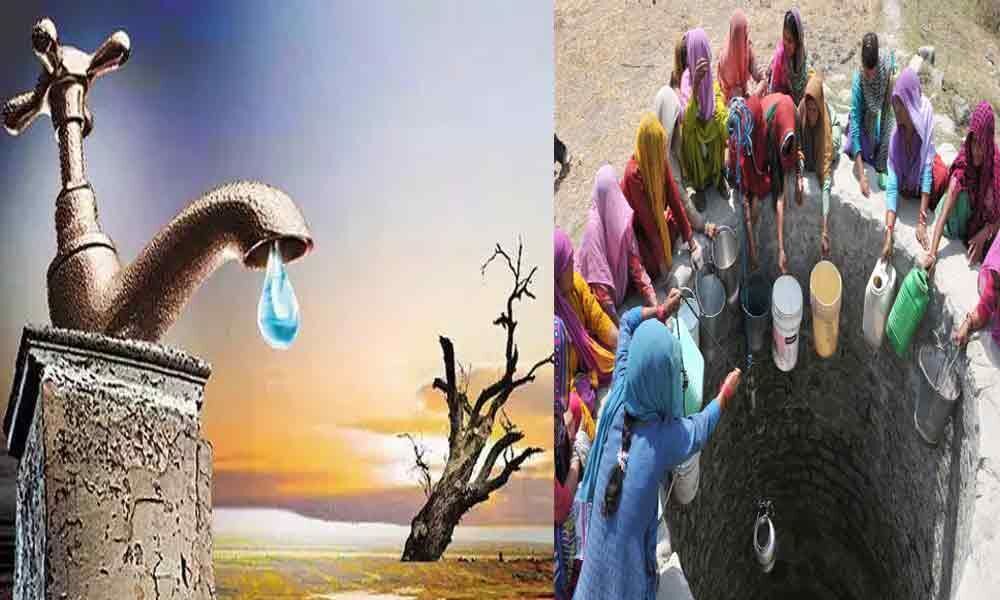Live
- Over 7,600 Syrians return from Turkiye in five days after Assad's downfall: minister
- Delhi BJP leaders stay overnight in 1,194 slum clusters
- Keerthy Suresh and Anthony Thattil Tie the Knot in a Christian Ceremony
- AAP, BJP making false promises to slum dwellers for votes: Delhi Congress
- 'Vere Level Office' Review: A Refreshing Take on Corporate Life with Humor and Heart
- Libya's oil company declares force majeure at key refinery following clashes
- Illegal Rohingyas: BJP seeks Assembly session to implement NRC in Delhi
- Philippines orders full evacuation amid possible volcanic re-eruption
- Government Prioritizes Welfare of the Poor, says Dola Sri Bala Veeranjaneyaswamy
- Two Russian oil tankers with 29 on board damaged due to bad weather
Just In
Is India Facing It's Worst Ever Water Crisis?


India is facing one of its most severe and major water crises. It also warns that, despite increasing demand, 21 cities are likely to run out of groundwater by 2020.
India is facing one of its most severe and major water crises. It also warns that, despite increasing demand, 21 cities are likely to run out of groundwater by 2020. As 80% of water is used in agriculture, this would also threaten food security. In the summer, Indian cities and towns run out of the water regularly because they lack the infrastructure to supply piped water to each home. There is also a lack of access to clean water in rural areas. They cannot rely on groundwater because of erratic rains and the fact that when monsoon rains are delayed or insufficient, the groundwater is increasingly used for farming. Water woes in Bangalore: the Silicon Valley of India dries up Is India facing its worst water crisis ever? The 'water mother' from India helps villages. Around 200,000 Indians die each year because, according to the report, they do not have access to clean water. Many ends up relying on government-paying private water suppliers or tankers. Winding queues of people waiting for tankers or public taps to collect water is a common sight in slums in India.
After two consecutive years of weak monsoons, 330 million people are affected by a severe drought — a quarter of the country's population. With almost 50% of India struggling with drought-like conditions, the situation has been particularly grim this year in western and southern states receiving below-average rainfall. According to the Composite Water Management Index (CWMI), 2018 report by Niti Aayog, 21 major cities (Delhi, Bengaluru, Chennai, Hyderabad, and others) are racing to reach zero groundwater levels by 2020, affecting 100 million people access. However, 12% of India's population is already living the 'Day Zero' scenario due to excessive groundwater pumping, an inefficient and wasteful water management system and years of deficient rainfall. The CWMI report also states that the country's water demand is projected to be twice the available supply by 2030, implying severe water scarcity for hundreds of millions of people and a possible 6% GDP loss in the country. Recently, a new Jal Shakti (water) ministry has been formed by the Union government to address water issues with a holistic and integrated perspective on the subject. The ministry announced an ambitious plan to provide piped water connections for all households in India by 2024. At a time when there is no access to clean water for hundreds of millions, the ministry has set a tough target. In order to lay enormous networks of water supply pipelines, we are once again giving more preference to infrastructure.
Also, the moot questions are: what if there is no water supply? What will happen to all the generated wastewater? This indicates that there is a clear disconnection between water, society, and economy. Currently, we are interested in laying large networks, building huge dams for storage, collecting water from 150 kilometres above, with a huge carbon footprint involved. We value land more than water, neglecting our local water bodies that either went dry or invaded. Also, in many Indian cities, water is not properly distributed. Some areas of mega cities like Delhi and Mumbai have the privilege of obtaining more than the standard municipal water standard of 150 liters per capita per day (lpcd), while other areas receive 40-50 lpcd. The problem is aggravated by the fact that drinking water standards are the water currently being supplied. The World Health Organization (WHO) states that an individual needs about 25 litres of water per day to meet his basic hygiene and food needs. The rest is used for non-potable purposes like mopping and cleaning. This indicates that for most non-potable uses, a quality lower than drinking water is needed. Therefore, water must be treated and supplied to be used for economic efficiency and sustainability of the environment. Overall, leakage loss, water pricing, and water metering are issues. Failure to maintain the existing infrastructure properly results in additional losses of almost 40% of the piped water in urban areas.
A paradigm shift is needed in view of the current situation. We urgently need a transition from this 'more water supply and supply' to measures to improve water efficiency, reduce leakage, recharge/restore local water bodies and apply for higher tariffs and ownership by various stakeholders. A closed system of loops based on recovery is the need for the hour. It's time to come back and start using our traditional practice of rainwater harvesting — catching water where it falls. India currently only captures 8% of the lowest annual rainfall in the world. Another aspect is the treatment and reuse of wastewater. About 80% of household water leaves as waste and contaminates our water bodies and the environment. At least for non-potable purposes, which is cost-effective, there is enormous potential to reuse and recycle this treated wastewater. All this leads to the fact that we need to promote a decentralized approach with a focus on water conservation, source sustainability, storage, and reuse as much as possible. It is important to understand that it is not the task of engineers alone to manage the water situation, but of all stakeholders including hydrogeologists, economists, planners and, most importantly, communities. The emphasis on behavioural change is not getting enough attention because it is complex and nuanced. But local/citizens/communities have a huge role to play. By keeping our own use and actions in control, we can contribute. They have to think about our decision-makers again: are we selling dreams or realities?
There is a TimeLine Forecast How Future is Going to be From now...
2019: CHENNAI ALMOST RUNS OUT OF WATER
2020: 21 CITIES INCLUDING BENGALURU, DELHI, HYDERABAD, TO RUN OUT OF WATER
2030: 40% OF INDIANS WILL HAVE NO ACCESS TO DRINKING WATER
2040: THERE WILL BE NO DRINKING WATER IN ALMOST ALL OF INDIA
THEREFORE :
1. Implement mandatory rainwater harvesting for irrigation purposes
2. Impose fines on Unnecessary water wastage
3. Ensure water is available to all but more expensive to ones in the higher tax and usage bracket
4. Educate & assist people on water conservation.
Please use a Bucket and you will find a notable difference. Each family can save at least 300 litres of water per day with minor changes in lifestyle.
save water save your Future.
Washing clothes- By Running Tap- 116 Litres
If you use the Bucket, only 36 litres is used.
Don't waste water unnecessarily save water for the next generations. save the future.

© 2024 Hyderabad Media House Limited/The Hans India. All rights reserved. Powered by hocalwire.com






